When we talk about donkeys, the first thing that may cross our minds is a slow and stubborn animal. But this is far from the truth because properly trained donkeys are obedient, intelligent, and loyal to their owners.
Donkeys were first domesticated and bred in Egypt and North America for their meat and milk. Today, they are considered multi-purpose animals. As a matter of fact, donkeys have been used in many underdeveloped countries to herd livestock, pull heavy loads, and do other farm work.
If you are thinking of raising donkeys and making them a part of your family, then look no further. This article will serve as the ultimate guide for you to successfully raise these animals. Without wasting any time, let’s jump right into it.
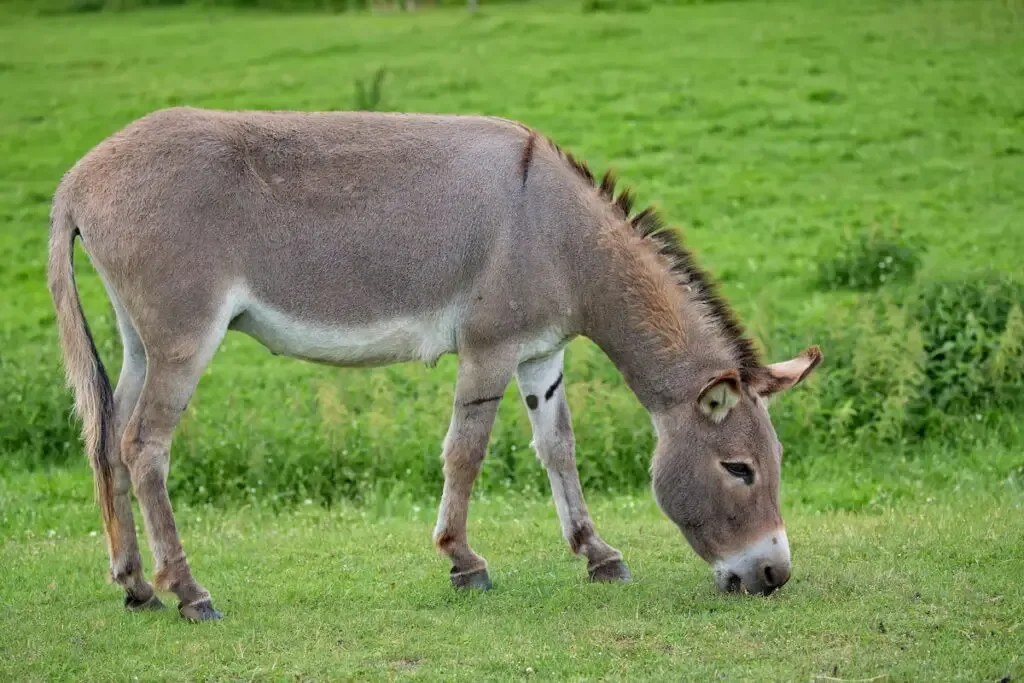
Donkeys or Mules: Know The Difference
Knowing how to differentiate between donkeys and mules is important in your equine selection. You don’t want to end up purchasing the wrong ones due to a lack of information and end up regretting it later.
As you already know, donkeys are generally short and hardier than horses. This is why they have been used to carry heavy loads since ancient times.
On the other hand, mules are produced when a male donkey is crossed with a mare, or a female horse. Mules generally inherit both of their parents’ traits and characteristics. To produce mules, you can’t cross a mule with another mule. This is because they are sterile and aren’t able to reproduce.
There are also other physical traits that separate donkeys from mules. Donkeys typically have long ears, flat backs, coarse manes, small hooves, and thin tails. They also don’t have the wither bump that is generally present on horses.
Meanwhile, mules carry both donkeys’ and horses’ traits in their genetics. To any untrained eyes, trying to recognize mules can be quite a challenge. But if you look close, there are certain physical traits that separate mules from donkeys.
For instance, mules have flatter spines and a much larger body size. They inherit the strength from horses and the endurance from donkeys.
Also, mules possess a delicate bone structure and tend to follow orders quicker than donkeys. But this doesn’t necessarily mean untrained mules are easy to handle. Like donkeys, mules also need proper training and time with their owners.

Choosing The Best Donkey Breeds
Donkeys are commonly raised for milk, draught work, and family pets. They come in different colors, shapes, and forms, and in several distinct breeds. Be it purebred or crossbreds, donkeys are classified based on their distinctive features including physical traits, colors, sizes, and coat textures.
Certain breeds have also been categorized based on their native place and regions where they mostly can be found. Here are the 11 most popular donkey breeds that can be found in the United States and other regions in the world:
· Standard
Being the most common donkeys out there, standard donkeys generally stand between 3 and 4 feet tall. They are also called English donkeys, Irish donkeys, Common Ass, and Anglo-Irish donkeys. They are docile, friendly, easy to handle, and are able to get along with livestock as companions.
Most standard donkeys come in different colors ranging from black, brown, gray, and a combination of all these three colors. A white coat is considered rare for this breed.
· Abyssinian
Abyssinian donkeys are similar to the Sudanese Pack donkeys. They can be commonly found in Ethiopia and can live up to 40 years old. These donkeys stand between 2.6 and 3.3 feet tall and weigh around 190 to 450 pounds. Their coats generally come in two colors; slate gray and chestnut brown.
· Asinara
These donkeys are native to the island of Asinara, on the northwest coast of Sardinia, Italy. Descended from wild donkeys, Asinaras are mostly gray in color with small carrier groups that possess the albino genes in their DNA. There are around 120 of these donkeys on the island while others are being protected and preserved in other regions in Italy including Alghero, Foresta Burgos, Emilia Romagna, and Tuscany.
· Amiatina
The Amiatinas are another Italian donkeys that originated in Tuscany, Italy. These medium to large-sized donkeys almost came to close to extinction in the early 20th century, right after the war. Preventive measures were taken to preserve this breed and in 2007, they were considered as endangered species.
Amiatinas possess mouse-gray coats, with cross-shaped markings on their dorsal and shoulder, and random stripes on their legs. Being a hardy breed, these donkeys can reach a height of 4.6 feet and weigh around 330 to 440 pounds.
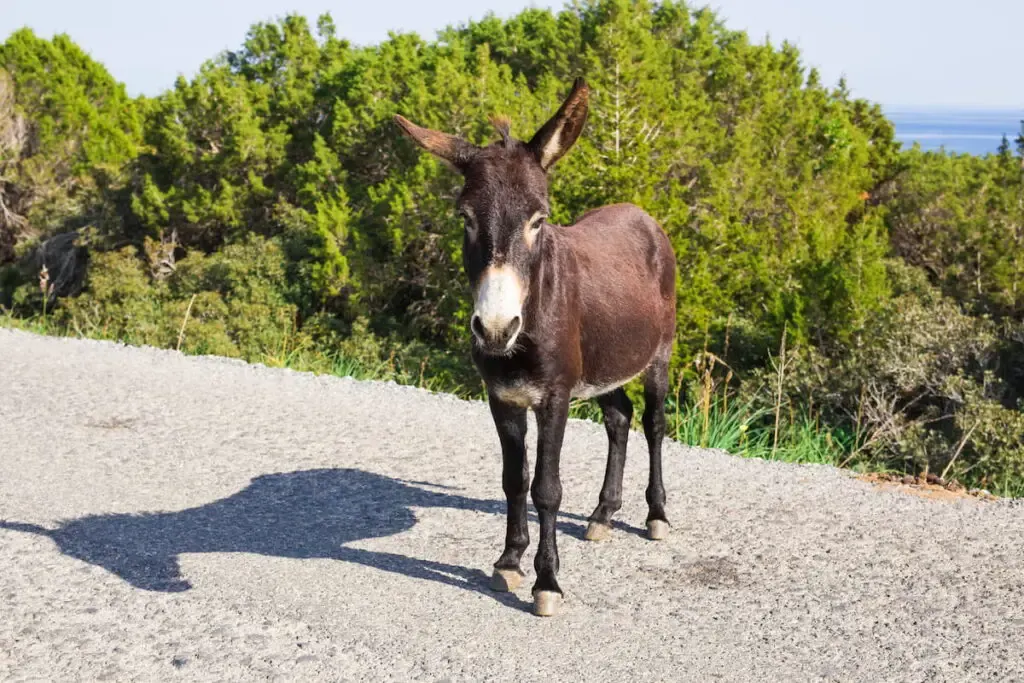
· Andalusian
The Andalusians are one of the oldest European breeds and they have existed since 3,000 years ago where they were used primarily by the Spanish military for stud.
These donkeys are native to the province of Cordoba in Andalusia, Spain. They generally stand between 4.9 and 5.2 feet high. Today, these donkeys are categorized as endangered species due to their low population in the world.
· Bourbonnais
These donkeys originated in the Auvergne region of central France. The Bourbonnais donkeys generally stand between 3.9 and 4.4 feet high. They can be recognized by their dark dorsal and shoulder stripes, zebra-striped legs, and grey-white coloration on their lower muzzle and belly.
Their coats also come in different colors ranging from black, brown, bay, chocolate, and dark bay. Even today, these donkeys are being used mainly as pack animals for hiking or carrying loads at farms.
· Catalan
Catalan donkeys are native to the region of Catalonia in north-eastern Spain and south-western France. They are one of the oldest donkey breeds in the world and are categorized as endangered species. Today, there are only around 500 purebred Catalans in the world.
The Catalans are large-sized donkeys that weigh around 900 to 1200 pounds and stand between 4.5 and 4.7 feet high. They can be recognized by their thick dark-colored coats, long ears, and white coloration on their muzzle.
· Cotentin
Cotentin donkeys are native to the lower region of Normandy in northwest France. Before, they were primarily used in farm work and as pack animals to transport goods and heavy loads. Today, these donkeys are used in many modern activities ranging from trekking, recreational and therapeutic riding, and also as companions or family pets.
Contentin donkeys generally weigh around 330 to 551 pounds and stand between 3.7 and 4.4 feet high. These donkeys can be recognized by their dove-grey coats, zebra-striped legs, white muzzle, and light-colored underbelly. They also have distinctive, dark stripes on their back and shoulder.
· Mammoth Jack Stock
Mammoth Jack Stock donkeys are dubbed as the largest donkeys in the world. They were developed in the United States by George Washington back in his early years.
A few breeds were used to create Mammoth Jack Stock including the Maltese, Andalusian, Poitou, Catalan, and Majorcan. These large donkeys can be recognized by their distinctive dark brown coats and white coloration on their muzzle and underbelly. They stand approximately between 4.6 and 4.8 feet high.
· Poitou
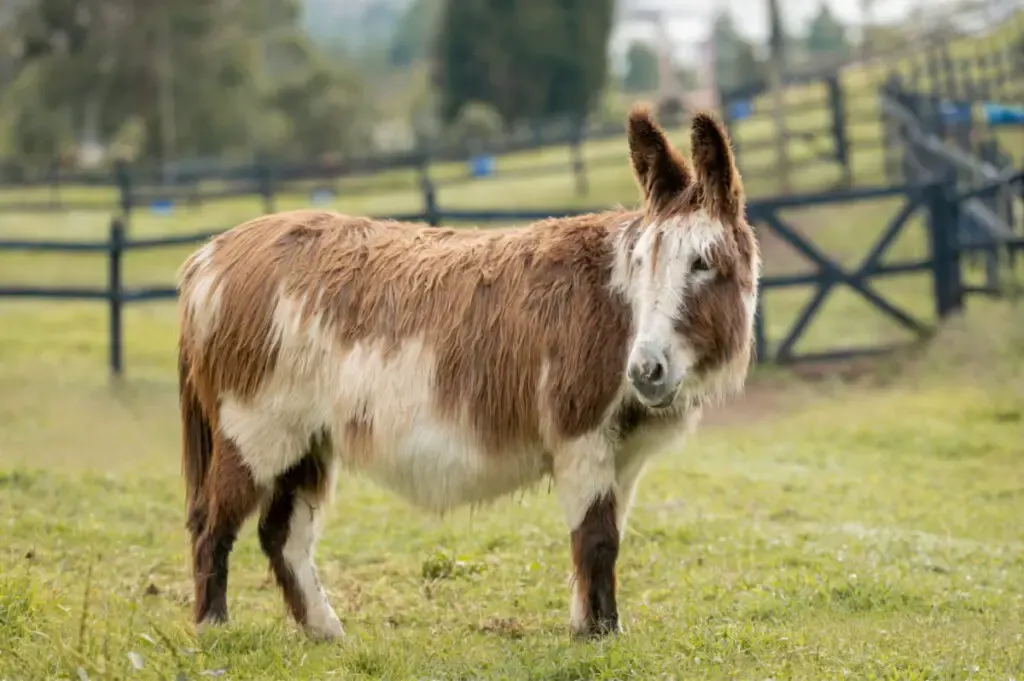
These large-sized donkeys originated from the Poitou region in France. In history, they were mainly used to breed large mules for farm work. These donkeys are famous for their distinctive thick coats called ‘cadanette’ that are long, thick, and look like ungroomed cords.
However, due to hygiene issues, most owners of this breed tend to keep the coat short. Poitou donkeys generally weigh around 750 to 950 and stand between 4.4 to 5 feet high. They also can be recognized by their large heads, sturdy neck, brown or black coats, grey underbelly, white nose, and eye rings.
· Mary
Mary donkeys are native to the Askhaad and Mary regions of Turkmenia. These large-sized donkeys stand between 3.8 and 3.9 feet tall and weigh around 650 pounds. Being hardy, they can thrive in hot and semi-arid environments. Most donkeys from this breed are used as pack animals for mountain expeditions and rescue missions.
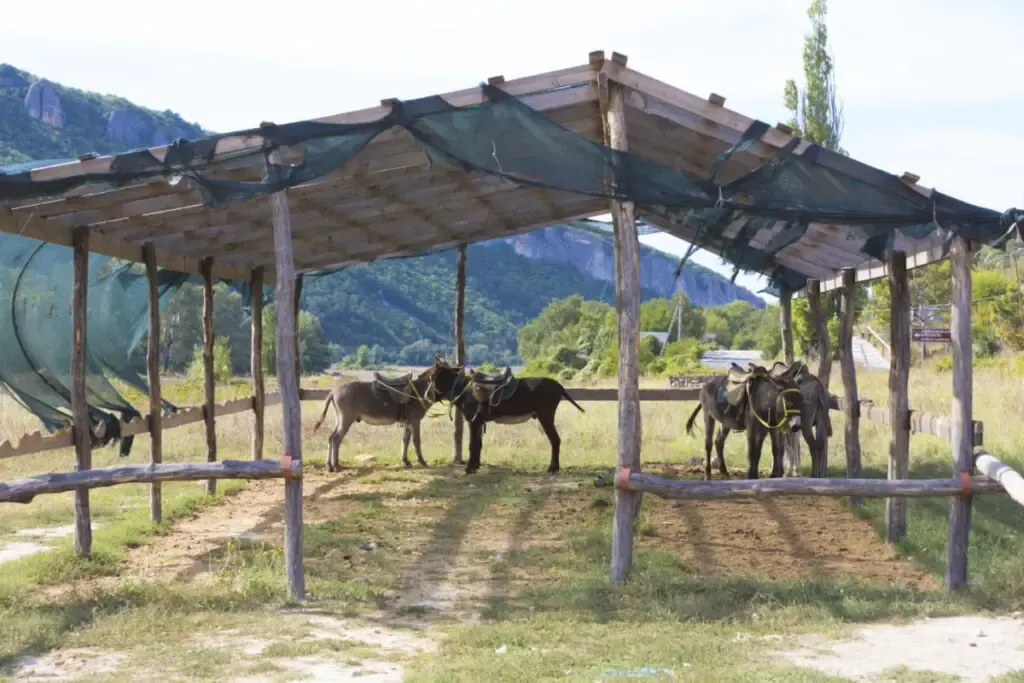
Building The Donkey Shelter
Donkeys love to spend their time grazing and roaming in the open field. However, they also need a safe indoor space that can protect them from the outdoor elements, harsh climates, and changing weather. Unlike horses, these equines also don’t have greasy coats that protect their bodies from water and wet environments.
Donkeys don’t need a fancy shelter to live happily. A clean, dry, three-sided barn or stable with properly-built fences is more than enough. Ideally, you should provide donkeys with 40 square feet of indoor space or an acre of space per animal.
But what’s more important is the shelter is properly ventilated. This feature is extremely important if you want your donkeys to stay inside the shelter, especially during hot and cold seasons. You can also insulate the barn or install basic circulating fans and indoor water misting fans to solve this issue.
If you’re living in a much colder region, an enclosed or four-sided shelter would be the most appropriate shelter to protect your donkeys from the weather. For long-term uses, the shelter must also be built from materials that could withstand extreme climates.
Then, you can cover the floor or the ground with slip-resistant materials to prevent your donkeys from slipping or falling when they run, especially during rainy days.
Inside the shelter, donkeys also need proper beddings for them to rest and sleep. Straw bedding is the most suitable one, especially barley straw. This is because it dries quicker, is light, easy to move, and doesn’t trap moisture. The only thing that you should do is regular bedding changes when the straw is dirty, spoiled, or moldy.
As long as there is enough room for them to walk, exercise, and move, building a good shelter for your donkeys is not that hard.
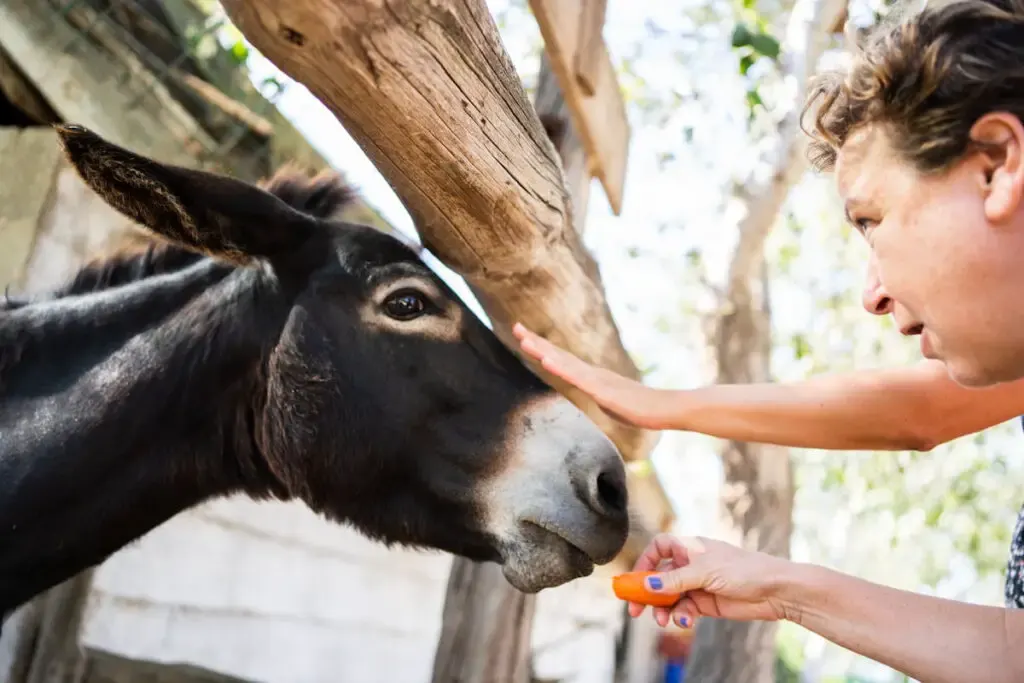
Feeding Habit: Diet And Nutrition
Although they have the ability to survive in semi-arid environments with low access to highly nutritious food, donkeys still need a balanced diet that consists of fiber, roughage, vitamins, and other supplementary nutrients. Like other equines, donkeys are also ‘trickle feeders’.
Through trickle feeding, donkeys are able to keep their digestive system healthy by continuously feeding on a fibrous diet in small quantities for the whole day.
To make sure your donkeys grow properly, there are a few essential foods that you must include in their diet. For instance:
· Hay
Donkeys need a diet that is high in fiber, low in protein and sugar. To achieve this, you can provide them with a good amount of hay. There are different types of hay that you can purchase for these animals such as meadow hay and seed hay.
Meadow hay is highly fibrous. It is produced from a mixture of grasses grown on old pasture. Meanwhile, seed hay is produced from planted crops such as timothy or rye.
No matter which hay they eat, be sure to check for any signs of ragwort. Ragwort poisoning can lead to death when donkeys ingest these dried plants that are hard to identify once they’re mixed with hay. Lastly, always keep the hay fresh and clean during winter.
This is because, in cold months, wet and humid environments promote the growth of mold on the hay. Moldy hay could cause allergies in donkeys or worse, make them sick when they feed on these toxic fungi.
· Straw
Feeding your donkeys with straw will ensure that the amount of fiber in their diet is at an optimum level. There are many options to go with but the best one would be high-quality barley straw. Barley straw is high in fiber, low in sugar and calories.
You don’t have to worry about weight issues in donkeys when they constantly feed on this food. On the other hand, if your donkeys are slightly underweight, you can feed them with an oat straw that is high in nutrients and calories.
But if you’re raising young donkeys, feed them with wheat straw that contains low-energy value but is highly fibrous. This can keep their newly grown teeth and gums healthy by not eating foods that are hard to chew.
· High-Fiber Pellets
High-fiber pellets are another additional feed that you can add atop hay and straw. These pellets can be purchased at any equine market or supply store. When feeding your donkeys for the first time, add a little water and low-sugar chaff into the mix.
This could prevent colic and choking issues in these animals. You can also grind high-fiber pellets into a fine mash and feed it to young donkeys or the ones with teeth problems.
· Dried Sugar Beet Pulp
Sugar beet, be it fresh or dried, is a fibrous, highly nutritious plant that can be used as a treat for your donkeys. Additionally, you can also add this into the mix of their primary food. When feeding them with dried sugar beet pulp, be sure to soak these cubed morsels with water at least 24 hours earlier.
Some specialized stores are also selling quick-soak sugar beet products that can be used between 10 and 15 minutes after soaking.
· Chaff Products
Chaff products are made from the dried, scaly casing of cereal grains, finely chopped straw, or even scaly dried plants. They are considered as one of the trickle feeding fibers that promotes the production of saliva in donkeys and buffers the acidity inside their stomach.
Chaff products are good for donkeys with laminitis or those suffering from high levels of sugar in the blood. This is due to the fact these products are highly fibrous, soft, and contain a low amount of glucose.
· Fruits And Vegetables
Apples, bananas, carrots, pears, strawberries, turnips, and celery are some of the fruits and vegetables that donkeys can eat. Although these things are highly nutritious, they should only be given to your donkeys as treats and appetizers. Also, be sure to cut or chop those fruits into tiny pieces to avoid choking problems.
· Minerals
Supplementing your donkeys with essential minerals can prevent any deficiencies that might interfere with their growth. This can be done by providing them with salt licks or mineral blocks. Always check the amount and ratio of minerals that these blocks offer to avoid mineral poisoning. Also, don’t feed donkeys with mineral blocks made for cattle, pigs, and livestock.
Last but not least, provide your donkeys with a constant supply of fresh and clean water. During hot seasons, they can drink a large amount of water to compensate for the external heat they receive.
Schedule regular cleaning of their feeders and waterers to remove any mold build-up or contamination caused by dirt and microorganisms. During cold months, always check whether their water has frozen.

Health Issues To Be Aware Of
Being hardy doesn’t mean donkeys are resistant to most diseases. Like horses, they are also prone to suffer from different illnesses, but in their own ways. Oftentimes, it is quite hard for donkey owners to detect any signs of diseases in their donkeys because these animals won’t show obvious behavioral changes when they’re sick.
But with enough time and experience, you will learn how to spot when your donkeys are under the weather. Here are some of the health issues that commonly happen in donkeys:
· Laminitis
This condition happens due to the inflammation of the laminae that connects the horse’s hoof to the coffin bone. One of the common types of laminitis in donkeys is support limb laminitis caused by injuries or abscesses.
· Arthritis
Statistically, older donkeys are prone to suffer from athritis. However, it can also happen in younger ones due to other factors including malnutrition, injury, restriction to move freely, and infection. Depending on symptoms and causes, it is better for you to consult a veterinarian if your donkeys are suffering from this illness.
· Lungworm
Lungworms are parasites known as Dictyocaulus arnfieldi, that live inside a donkey’s body system. Donkeys with lungworms will show symptoms such as coughing and irritation of their lungs. Veterinarians will use a fecal sample for further diagnoses before deworming these animals with ivermectin.
· Jack sores
Also known as summer sores, this disease is caused by house flies and stable flies that lay eggs on open wounds or near skin abrasions on donkeys. When the eggs hatch, the larval will cause irritation, extreme itchiness, and mild pain that takes a longer time to heal.
· Brucellosis
Brucellosis can be categorized into two types: poll evil and fistulous withers. In donkeys, fistulous withers commonly happens when the supraspinous bursa located near the withers are inflamed due to injuries, trauma, or infectious bacteria known as Brucella abortus.
· Dental problems
Teeth problems happen frequently as donkeys get older. But younger donkeys can also suffer from dental issues such as wolf teeth that grow on each side of the upper jaw. This could cause discomfort, especially when eating. Additionally, calcium deficiency could also contribute to brittle and weak teeth.
· Conjunctivitis
Conjunctivitis occurs around the donkey’s eyes, especially on the inner eyelid and the surrounding membrane. This condition is caused by many things such as dust, flies, fungal infections, viral diseases, injury, and irritants to the eyes. Pink Eye is another name for conjunctivitis that is caused by infections.
· Colic
Colic generally presents as abdominal pain. Causes and symptoms might vary depending on the diagnoses made by a veterinarian. There are different types of colic such as spasmodic colic, gas colic, torsion colic, and many more.
Symptoms of colic in donkeys appear with sudden behavioral changes including shortness of breath, dullness, lethargy, lack of appetite, excessive sweating, discoloration of gum, and raised heart rate.
· Sarcoids
These skin tumors are harder to treat at home. When you see any signs of thickened skin, lesions, or wart-like bumps on your donkeys, it is best for you to consult a veterinarian for help. Sarcoids can be found in any part of the body but commonly appear on the eyes, head, underlegs, mid-body, and groin.
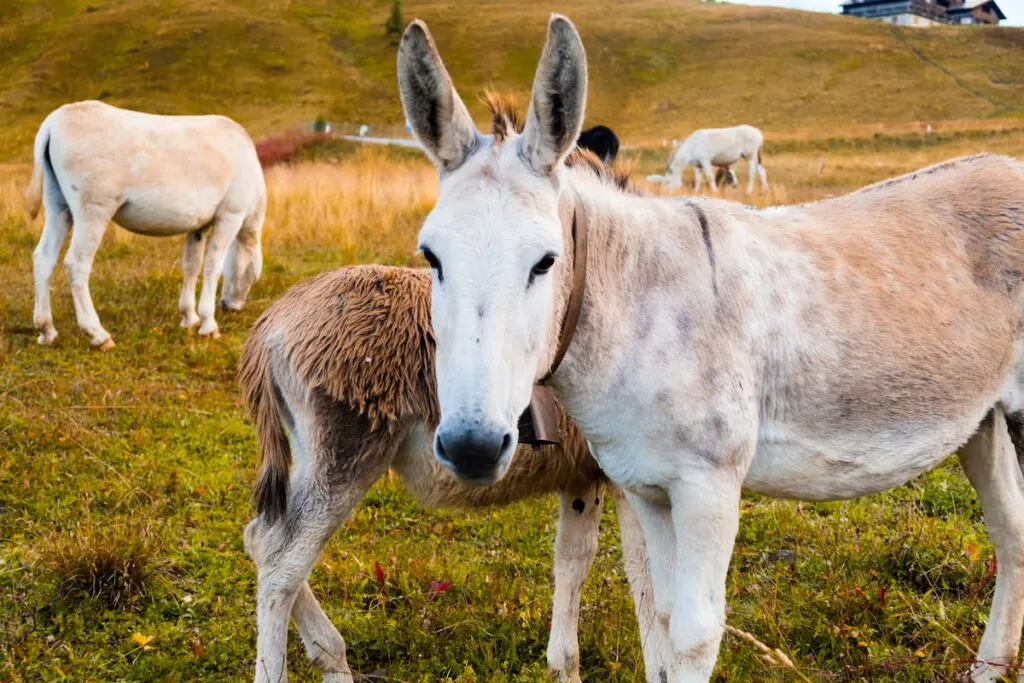
Final Thoughts
Although these equines aren’t nearly as famous as horses, they still have a place in people’s hearts. Whether you’re a beginner homesteader, a large-scale farm owner, or simply just an animal lover, there is no reason why you can’t raise donkeys successfully all by yourself.
Like other animals, donkeys need their owner’s love and attention. When they are happy, their health will improve more than you can imagine!
Citations
- https://animals.mom.com/how-to-raise-a-donkey-as-a-pet-7804944.html
- https://www.thedonkeysanctuary.org.uk/what-we-do/knowledge-and-advice/for-owners/what-to-feed-your-donkeys
- https://hellohomestead.com/what-are-donkeys-good-for/
- https://www.thedonkeysanctuary.org.uk/what-we-do/knowledge-and-advice/about-donkeys
- https://modernfarmer.com/2014/06/modern-farmers-guide-guard-donkeys/
- http://afs.okstate.edu/breeds/other/donkey/
- https://petkeen.com/types-of-donkey-breeds/
- https://donkeywise.org/donkey-info/about-donkeys/
- https://opensanctuary.org/article/building-a-good-home-for-donkeys/
- https://opensanctuary.org/article/common-donkey-health-issues/
- https://s3.us-east-2.amazonaws.com/thehorse/files/S/15-facts-about-donkey-health.pdf
